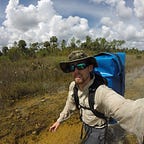Dodging Mammoths
By Leif Johnson | Conservancy of Southwest Florida Biologist
Before computers, before roads, before cities, and farming, language and indeed even while we were still burning ourselves trying to control fire, the gopher tortoise was here, burrowing in the sandy soils of a Florida that was nearly three times as big as it is today.
As residents of the state of Florida for nearly 2 million years, gopher tortoises are truly living relics of a time gone past and a testament to what it takes to survive. Deep in their burrows, extending more than 40 feet underground, they witnessed the extinction of many other Florida residents including dire wolves and 500 pound armadillos. The burrow has quite possibly been its one true saving grace and most likely the reasoning behind the scientific name Gopherus polyphemus, where polyphemus refers to the giant cyclops from The Odyssey that trapped Odysseus and his men in his cave. These skillfully crafted burrows have helped to buffer them from fire, predators and extreme climates throughout the years providing a safe and secure refuge for escape when needed.
Their hardened, calloused exterior, even at a young age, evokes a certain air of wisdom, a notion of resilience and endurance. Sturdy and solid, they have accumulated an instinctive understanding of the land, an understanding that is ingrained into every growth ring in their shell and every wrinkle in their skin. That knowledge has been passed on for millennia allowing for countless generations to succeed even as they dodged the thunderous footsteps of mammoths and 13 foot tall sloths. Yet through all the years of learning and evolving, this inherited body of knowledge had no way of preparing future generations for the inventions of automobiles, roads, buildings, and ultimately the unstoppable spread of their users.
Wallace Stegner once wrote “We are the most dangerous species of life on the planet, and every other species, even the earth itself, has cause to fear our power to exterminate. But we are also the only species which, when it chooses to do so, will go to great effort to save what it might destroy.”
The gopher tortoises need to burrow in high, sandy soils has put it directly in the path of development in Florida. Something that has inevitably caused some to see them as a hindrance, just another obstacle along the endless pursuit of progress, but in reality it should be a reminder, a symbol of the true price of progress.
Keystone
The Romans may have had a profound understanding of the term “keystone”, but it was Dr. Robert T. Paine who coined the term “keystone species” in the 1960’s. He found that even though certain species, like the ochre starfish and sea otter, may not be present in large numbers, they have a profound impact on their environment. A keystone species functions much like the architectural stone used in Roman arches where if removed the entire system falls apart. The gopher tortoise is widely accepted as a prime example of this term and may in shape, even faintly resemble an upside down keystone. Remove the tortoise from the equation and many other species will be negatively impacted. In fact, studies have found over 360 different species utilize their burrows in one way or another meaning the fate of an entire ecosystem is held up by the stout legs of this tortoise.
No species should have to justify their “worth” to society.
Somewhere along the relatively short timeline of human history, beside the evolution of thumbs and enlarged cranial capacities, came the uncovering of morality in our genus. Other creatures may have glimpsed this overtime, but for the most part nature exhibits an “implacable indifference.” So for possibly the first time in the history of the planet, a species has truly been able to grapple with the consequences of having a sense of morality — to struggle with the balance between our feelings of compassion and empathy and our need to survive.
Life is ripe with the strife that lies between helping and ignoring.
I would only hope that a species capable of such a struggle could one day find a way to live in unison with it, ultimately allowing a species like the gopher tortoise to live unimpeded by mans chaotic struggle for life — that we may learn to accept the hectic nature of our being and buffer those less able to adapt to our habits while at the same time acknowledging that we need nature, we are nature, and without it we are truly lost.
So the next time you see a gopher tortoise, whether it’s on a preserve like the one here at the Conservancy of Southwest Florida or on someone’s lawn in town, remember what it took for them to get here. Envision them sidestepping mammoths and think about the hundreds of other animals that rely on their unwavering presence, because though they may have avoided being crushed by the giants of the past they can’t escape the bulldozers in the future without our help.
